Design of a Damping Controller Using the SCA Optimization Technique for the Improvement of Small Signal Stability of a Single Machine Connected to an Infinite Bus System
Abstract
1. Introduction
- Novel machine parameters utilizing flux in the amortisseur windings are considered in the proposed model of the SMIB system.
- The proposed SMIB model linearizes the state space model matrix and a 9 × 9 dimension is obtained that is applied in the eigenvalue analysis.
- The SCA optimization technique shows improvement in exploration and exploitation processes and finds maxima or minima in the eigenvalue analysis.
- The proposed SCA is validated with the MFO and EP techniques.
2. Mathematical Model of SMIB System with PSS
- Operating in a steady state and having very low oscillating frequencies. The armature reaction introduces a negative synchronizing torque, and when its value exceeds , the system become monotonically unstable and the steady state stability limit is reached at K1 = .
- Operating at much higher oscillating frequencies than . The component of the air gap torque due to is in phase with Δω and leads by from Δδ. introduces a positive damping torque component.
- Operating at a 1 Hz oscillating frequency. introduces a negative synchronizing torque component and positive damping torque component. The collective effect is to increase the damping torque and reduce the synchronizing torque. When remains positive, introduces a positive damping torque component due to the armature reaction. is negative on two conditions: (1) when the hydraulic generator without damper windings is operating at a light load and connected with high resistance to the reactance ratio line of a large system or (2) when the hydraulic generator is partly supplied by a large, local, connected load and partly supplied by a remote generator set. In this condition, induced torques are out of phase with Δω and yield a negative damping.
- Steady state synchronizing torque coefficient.
- The damping torque and synchronizing torque components at oscillating frequency. When is negative for high values of the external system reactance and high generator outputs, the AVR increases the synchronizing torque component and reduces the damping torque component. The net synchronizing torque and damping torque are given as follows:
3. Analysis of Eigenvalues
- ,pass,min ≤ ,pass ≤ ,pass,max
- ,pass,min ≤ ,pass ≤ ,pass,max
- ,pass,min ≤ ,pass ≤ ,pass,max
4. Metaheuristic Optimization Techniques
4.1. Overview of the SCA Algorithm
4.2. Overview of the MFO Algorithm
4.3. Evolutionary Programming Algorithm
5. Results and Discussion
- SMIB system with an unoptimized PSS (PSSU)
- SMIB system with a PSS optimized by the sine cosine algorithm (PSS-SCA)
- SMIB system with a PSS optimized by the moth flame optimization (PSS-MFO)
- SMIB system with a PSS optimized by evolutionary programming (PSS-EP)
6. Conclusions
Author Contributions
Funding
Institutional Review Board Statement
Informed Consent Statement
Data Availability Statement
Conflicts of Interest
References
- Kundur, P. Power System Stability and Control, 3rd ed.; McGraw-Hill Education: New York, NY, USA, 1994; pp. 17–817. [Google Scholar]
- Machowski, J.; Bialek, J.W.; Bumby, J.R. Power System Dynamics: Stability and Control, 2nd ed.; John Wiley and Sons Ltd.: Chichester, UK, 1997. [Google Scholar]
- Anderson, P.M.; Fouad, A.A. Power System Control and Stability, 2nd ed.; Wiley-IEEE Press: Danvers, MA, USA, 2002. [Google Scholar]
- Hannan, M.A.; Islam, N.N.; Mohamed, A.; Lipu, M.S.H.; Ker, P.J.; Rashid, M.M.; Shareef, H. Artificial intelligent based damping controller optimization for the multi-machine power system: A review. IEEE Access 2018, 6, 39574–39594. [Google Scholar] [CrossRef]
- Kamari, N.A.M.; Musirin, I.; Ibrahim, A.A. Swarm intelligence approach for angle stability improvement of PSS and SVC-based SMIB. JEET 2020, 15, 1001–1014. [Google Scholar] [CrossRef]
- Yang, M.; Cao, W.; Lin, T.; Zhao, J.; Li, W. Low frequency damping control for power electronics-based AC grid using inverters with built-in PSS. Energies 2021, 14, 2435. [Google Scholar] [CrossRef]
- Wang, B.; Sun, K. Formulation and characterization of power system electromechanical oscillations. IEEE Trans. Power Syst. 2016, 31, 5082–5093. [Google Scholar] [CrossRef]
- Eslami, M.; Shareef, H.; Mohamed, A. Application of artificial intelligent techniques in PSS design: A survey of the state-of-the-art methods. Prz. Elektrotechniczny 2011, 87, 188–197. [Google Scholar]
- Zhang, Y.; Chen, G.P.; Malik, O.P.; Hope, G.S. An artificial neural network based adaptive power system stabilizer. IEEE Trans. Energy Convers. 1993, 8, 71–77. [Google Scholar] [CrossRef]
- Li, C.; Deng, J.; Zhang, X.-P. Coordinated design and application of robust damping controllers for shunt FACTS devices to enhance small-single stability of large-scale power systems. JPES 2017, 3, 399–407. [Google Scholar]
- Jiang, S.; Gole, A.M.; Annakkage, U.D.; Jacobson, D.A. Damping performance analysis of IPFC and UPFC controllers using validated small-single models. IEEE Trans. Power Deliv. 2011, 26, 446–454. [Google Scholar] [CrossRef]
- Parastvand, H.; Bass, O.; Masoum, M.A.S.; Chapman, A.; Lachowicz, L. Cyber-security constrained placement of FACTS devices in power networks from a novel topological perspective. IEEE Access 2020, 8, 108201–108215. [Google Scholar] [CrossRef]
- Zhou, L.; Swain, A.; Ukil, A. Reinforcement learning controllers for enhancement of low voltage ride through capability in hybrid power systems. IEEE Trans. Ind. Inform. 2020, 16, 5023–5031. [Google Scholar] [CrossRef]
- Guangzheng, Y.; Lin, T.; Zhang, J.; Tian, Y.; Yang, X. Coordination of PSS and FACTS damping controllers to improve small signal stability of large-scale power system. JPES 2019, 5, 507–514. [Google Scholar]
- Zuo, J.; Li, Y.; Shi, D.; Duan, X. Simultaneous robust coordinated damping control of power system stabilizers (PSSs), static var compensator (SVC) and doubly-fed induction generator power oscillation dampers (DFIG PODs) in multimachine power systems. Energies 2017, 10, 565. [Google Scholar] [CrossRef]
- Baek, S.-M.; Park, J.-W. Nonlinear parameter optimization of FACTS controller via real-time digital simulator. IEEE Trans. Ind. Appl. 2013, 49, 2271–2278. [Google Scholar] [CrossRef]
- Al-Ismail, F.S.; Hassan, M.A.; Abido, M.A. RTDS implementation of STATCOM-based power system stabilizers. CJECE 2014, 37, 48–56. [Google Scholar] [CrossRef]
- Pandey, R.K.; Gupta, D.K. Integrated multi-stage LQR power oscillation damping FACTS controller. JPES 2018, 4, 83–92. [Google Scholar] [CrossRef]
- Jiang, P.; Fan, Z.; Feng, S.; Wu, X.; Cai, H.; Xie, Z. Mitigation of power forced oscillations based on unified power flow controller. JMPSCE 2019, 7, 99–112. [Google Scholar] [CrossRef]
- Quan, W.; Su, Q. Improved adaptive backstepping approach on STATCOM controller of nonlinear power system. IEEE Access 2019, 7, 139109–139117. [Google Scholar] [CrossRef]
- Asgharian, A.; Tavakoli, S.A. A systematic approach to performance weights selection in design of robust H PSS using genetic algorithms. IEEE Trans. Energy Convers. 1996, 11, 111–117. [Google Scholar] [CrossRef]
- Kahouli, A.; Guesmi, T.; Abdallah, H.H.; Quali, A. A genetic algorithm PSS and AVR controller for electrical power system stability. In Proceedings of the 6th International Multi-Conference on Systems, Signals and Devices, Djerba, Tunisia, 23–26 March 2009. [Google Scholar]
- Hassan, L.H.; Moghavvemi, M.; Almurib, H.A.F.; Muttaqi, K.M. A coordinated design of PSSs and UPFC-based stabilizer using genetic algorithm. IEEE Trans. Ind. Appl. 2014, 50, 2957–2966. [Google Scholar] [CrossRef]
- Gupta, N.; Agarwal, T. Design of optimal power system stabilizer using GA and PSO: A comparative study. In Proceedings of the IEEE International Conference on Recent Advances and Innovations in Engineering, Jaipur, India, 23–25 December 2016. [Google Scholar]
- Verdejo, H.; Pino, V.; Kliemann, W.; Becker, C.; Delpiano, J. Implementation of particle swarm optimization (PSO) algorithm for tuning of power system stabilizers in multimachine electric power systems. Energies 2020, 13, 2093. [Google Scholar] [CrossRef]
- Islam, N.N.; Hannan, M.A.; Shareef, H.; Mohamed, A. Power system stabilizer design using BAT optimization algorithm in multimachine power system. In Proceeding of the IEEE Student Conference on Research and Development, Putrajaya, Malaysia, 16–17 December 2013. [Google Scholar]
- Sheshnarayan; Verma, B.; Padhy, P.K. Design PID Controller based PSS using cuckoo search optimization technique. In Proceedings of the 4th International Conference on Recent Trend on Electronics, Information, Communication & Technology, Bengaluru, India, 17–18 May 2019. [Google Scholar]
- Islam, N.N.; Hannan, M.A.; Shareef, H.; Mohamed, A. SVC Damping controller design based on firefly optimization algorithm in multi machine power system. In Proceedings of the IEEE Conference on Clean Energy and Technology, Langkawi, Malaysia, 18–20 November 2013. [Google Scholar]
- Verdejo, H.; Torres, R.; Pino, V.; Kliemann, W.; Becker, C.; Delpiano, J. Tuning of controllers in power systems using a heuristic-stochastic approach. Energies 2019, 12, 2325. [Google Scholar] [CrossRef]
- Kamari, N.A.M.; Musirin, I.; Hamid, Z.A.; Rahim, M.N.A. EP-based optimisation for estimating synchronising and damping torque coefficients. AJBAS 2010, 4, 3741–3754. [Google Scholar]
- Mirjalili, S. SCA: A sine cosine algorithm for solving optimization problems. Knowl. Syst. 2016, 96, 120–133. [Google Scholar] [CrossRef]
- Mirjalili, S. Moth-flame optimization algorithm: A novel nature-inspired heuristic paradigm. Knowl. Syst. 2015, 89, 228–249. [Google Scholar] [CrossRef]

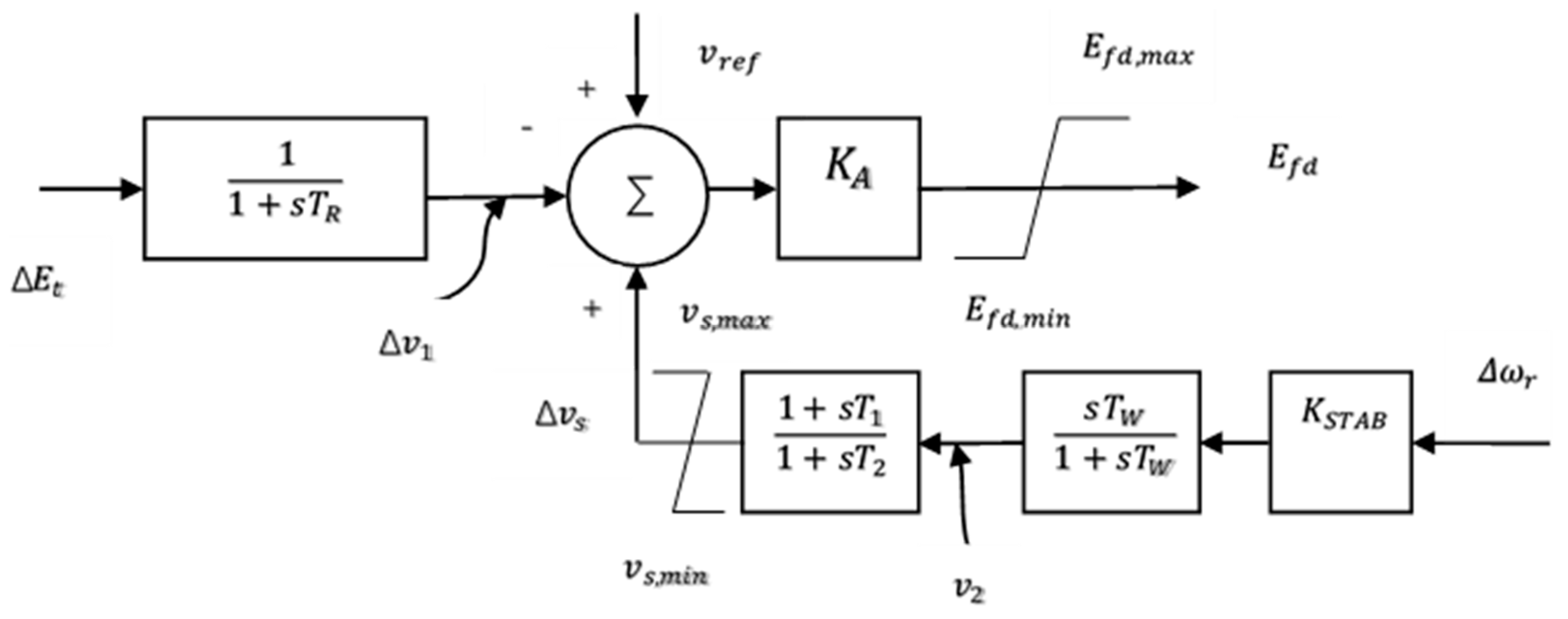

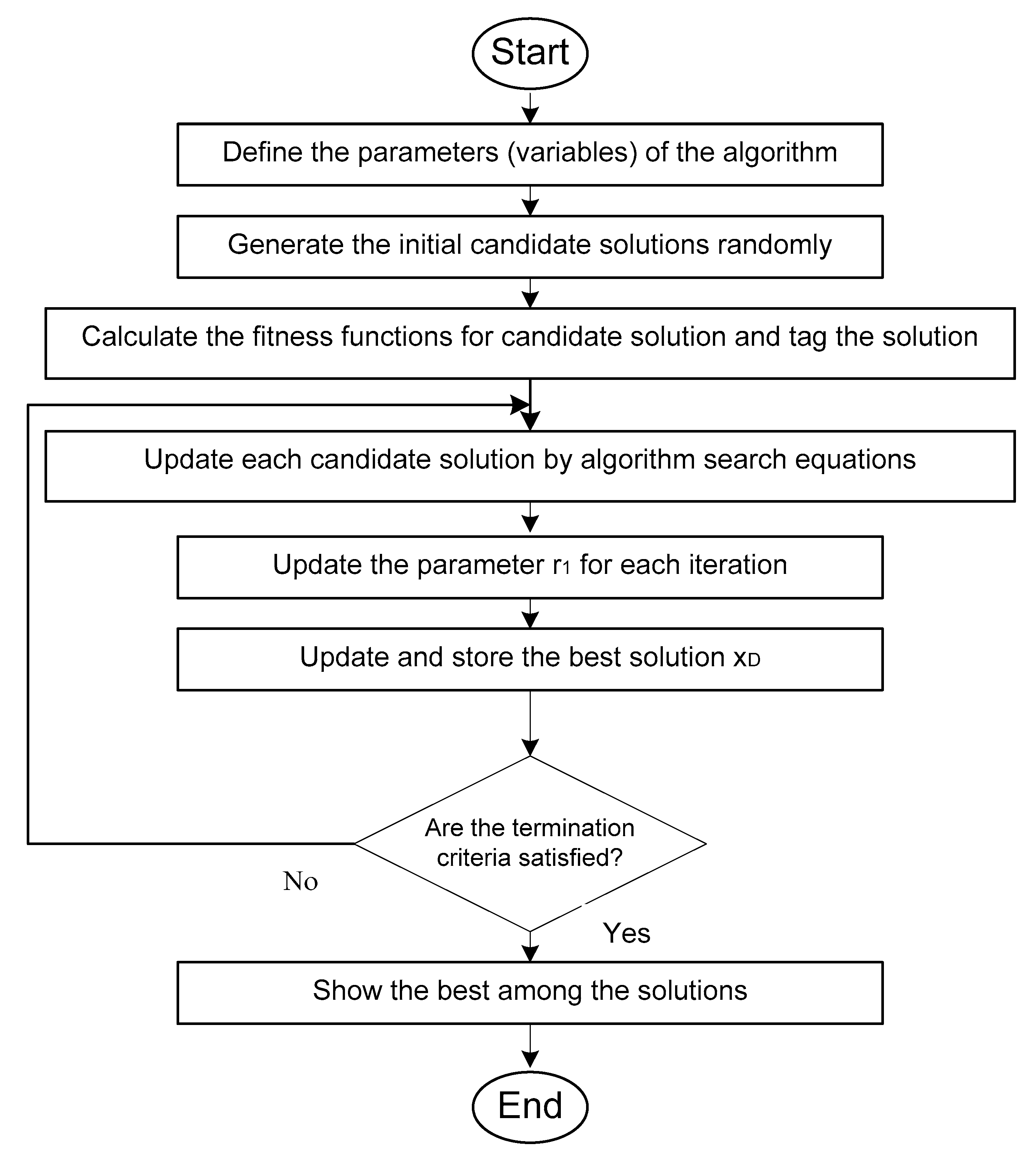
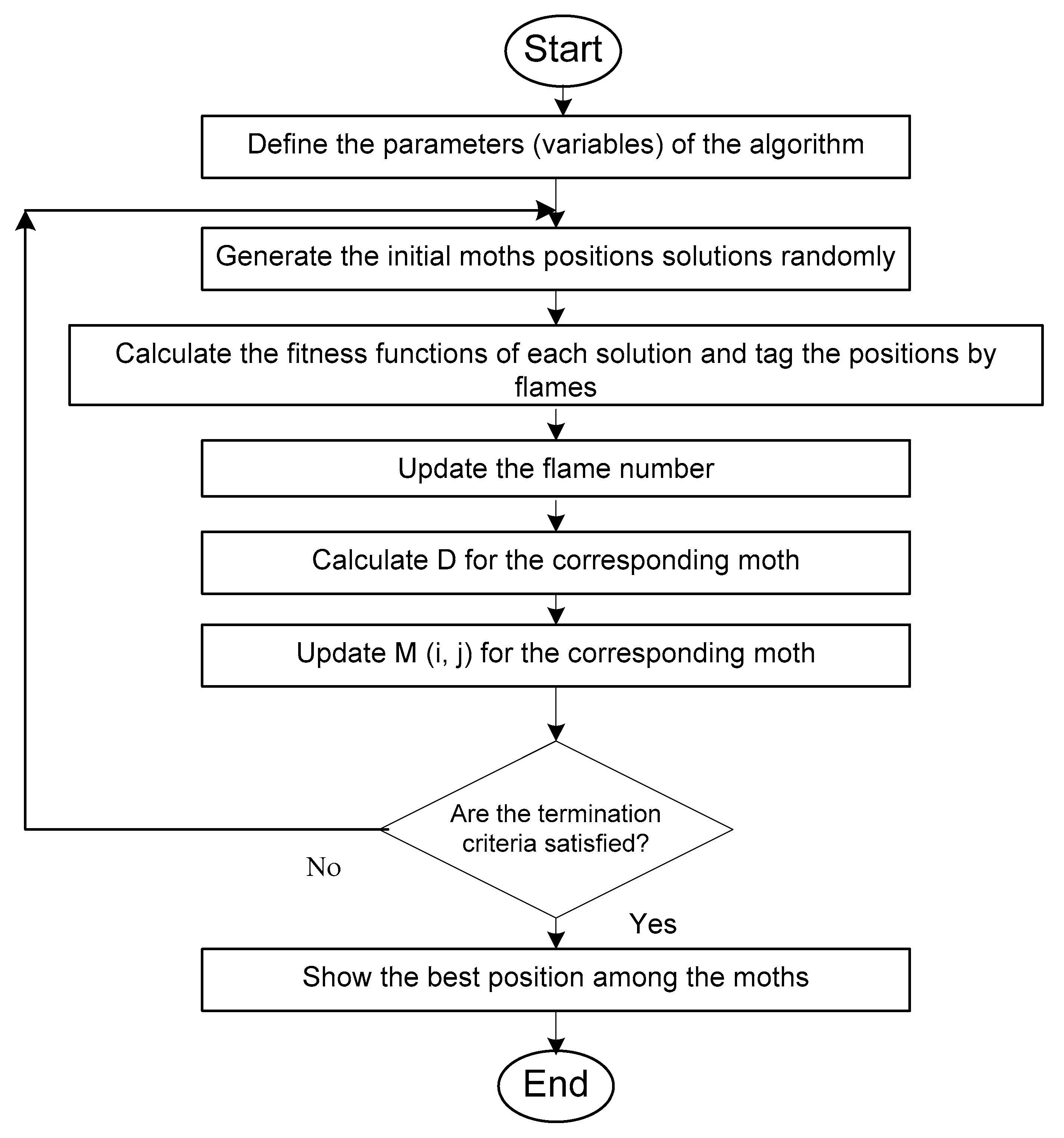
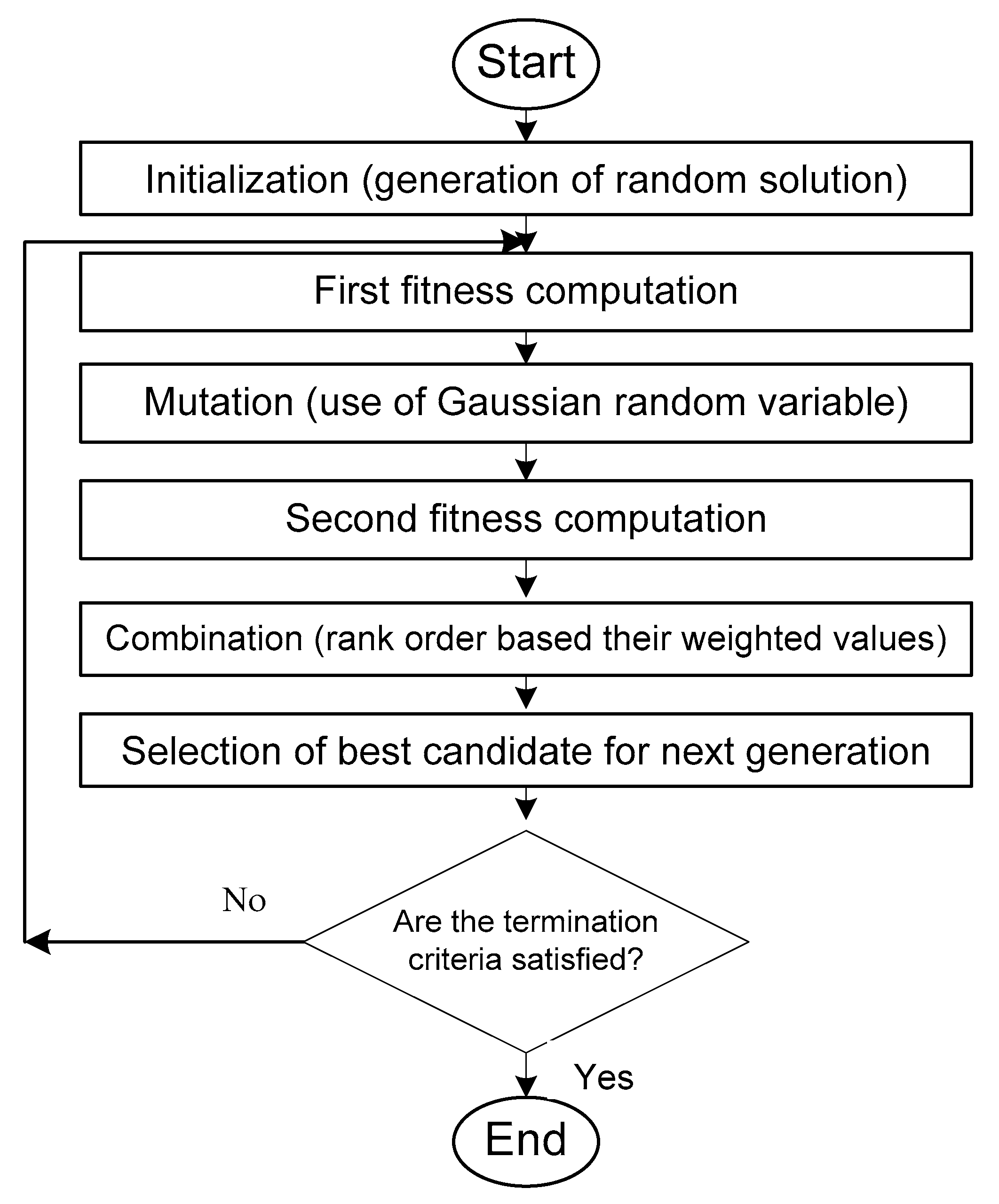
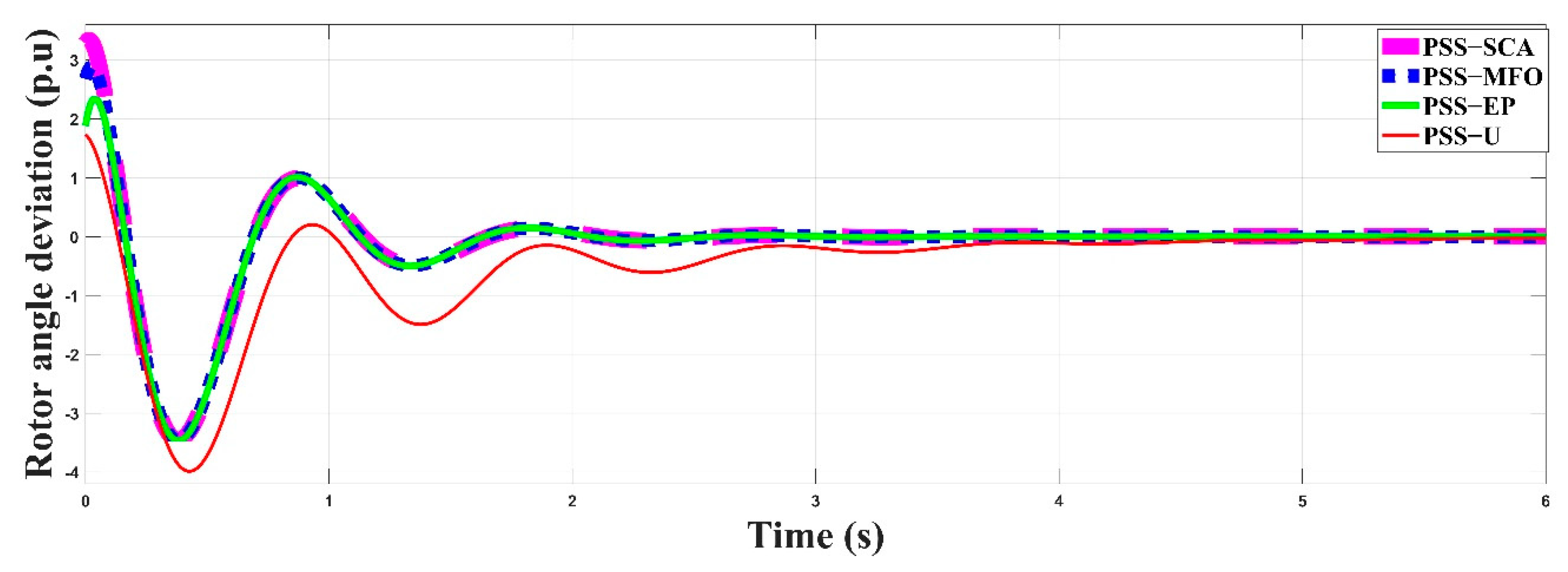
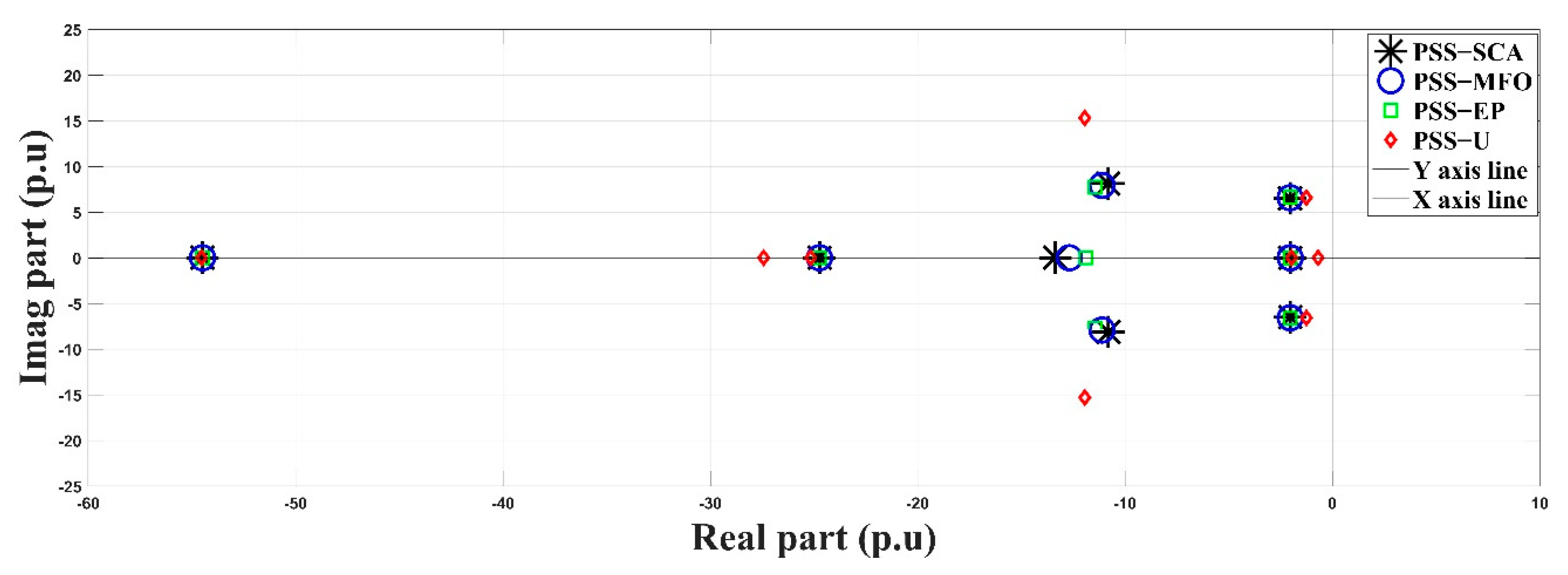
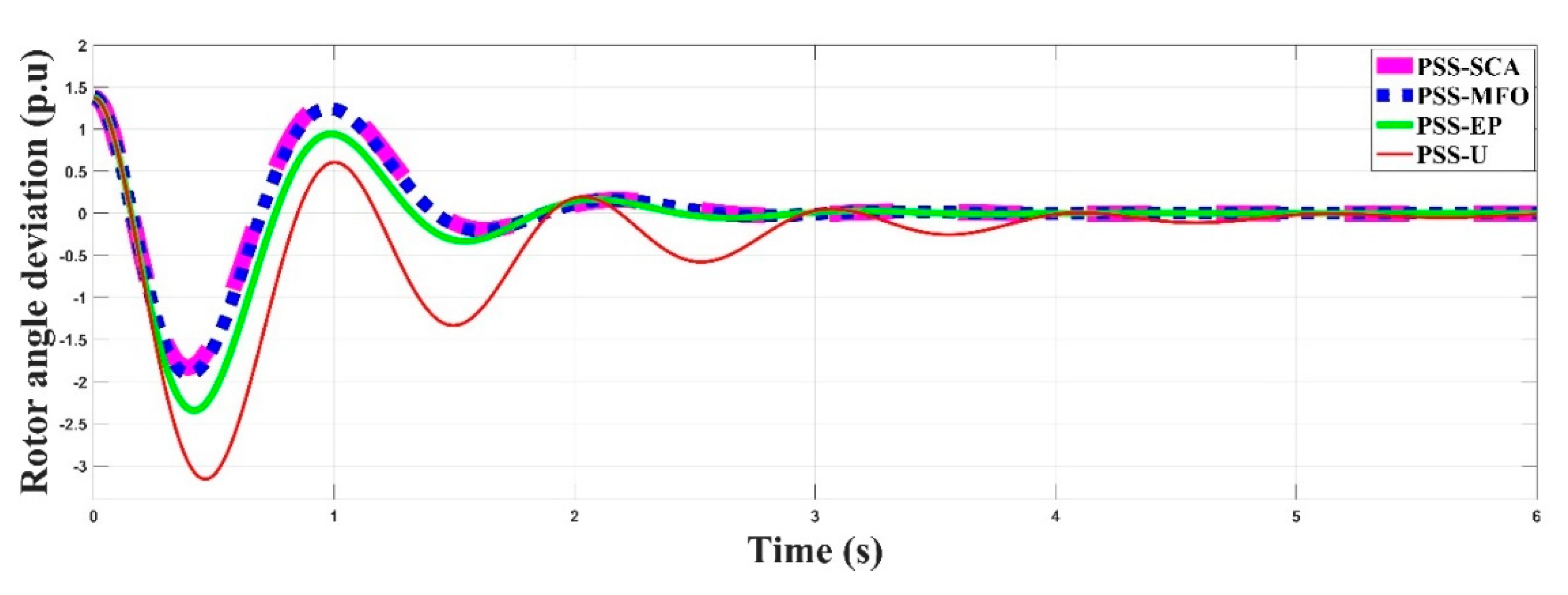
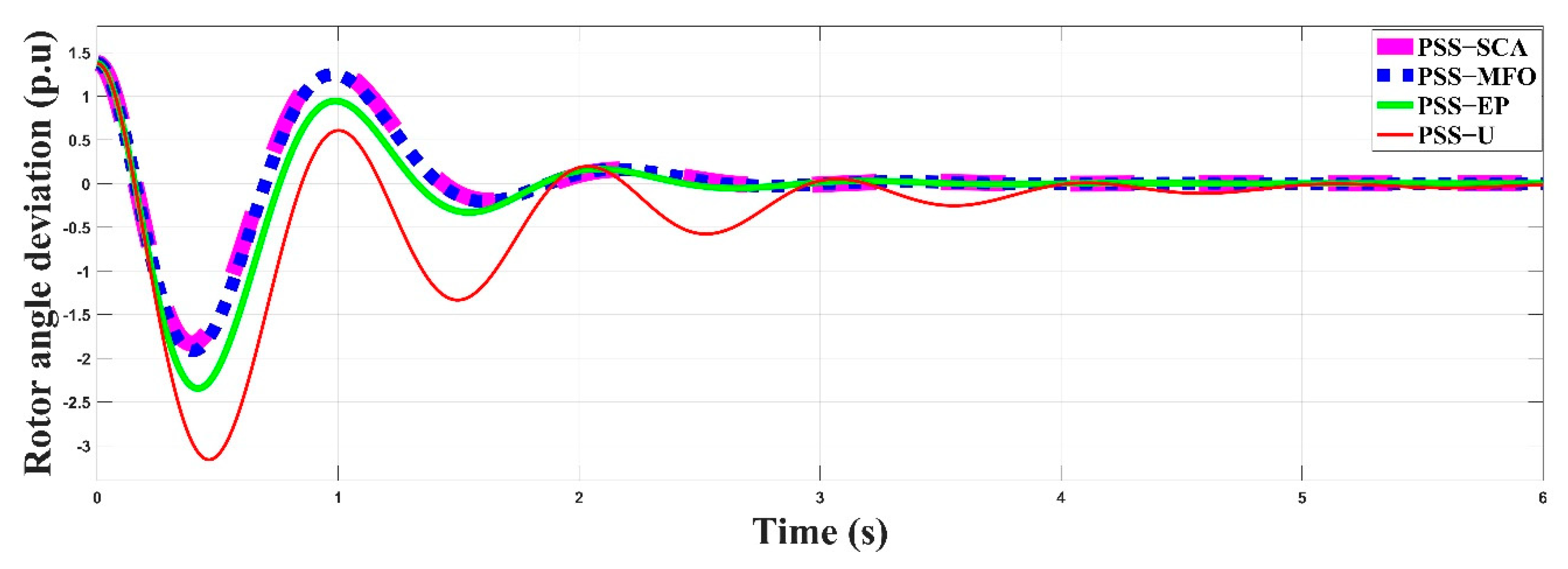
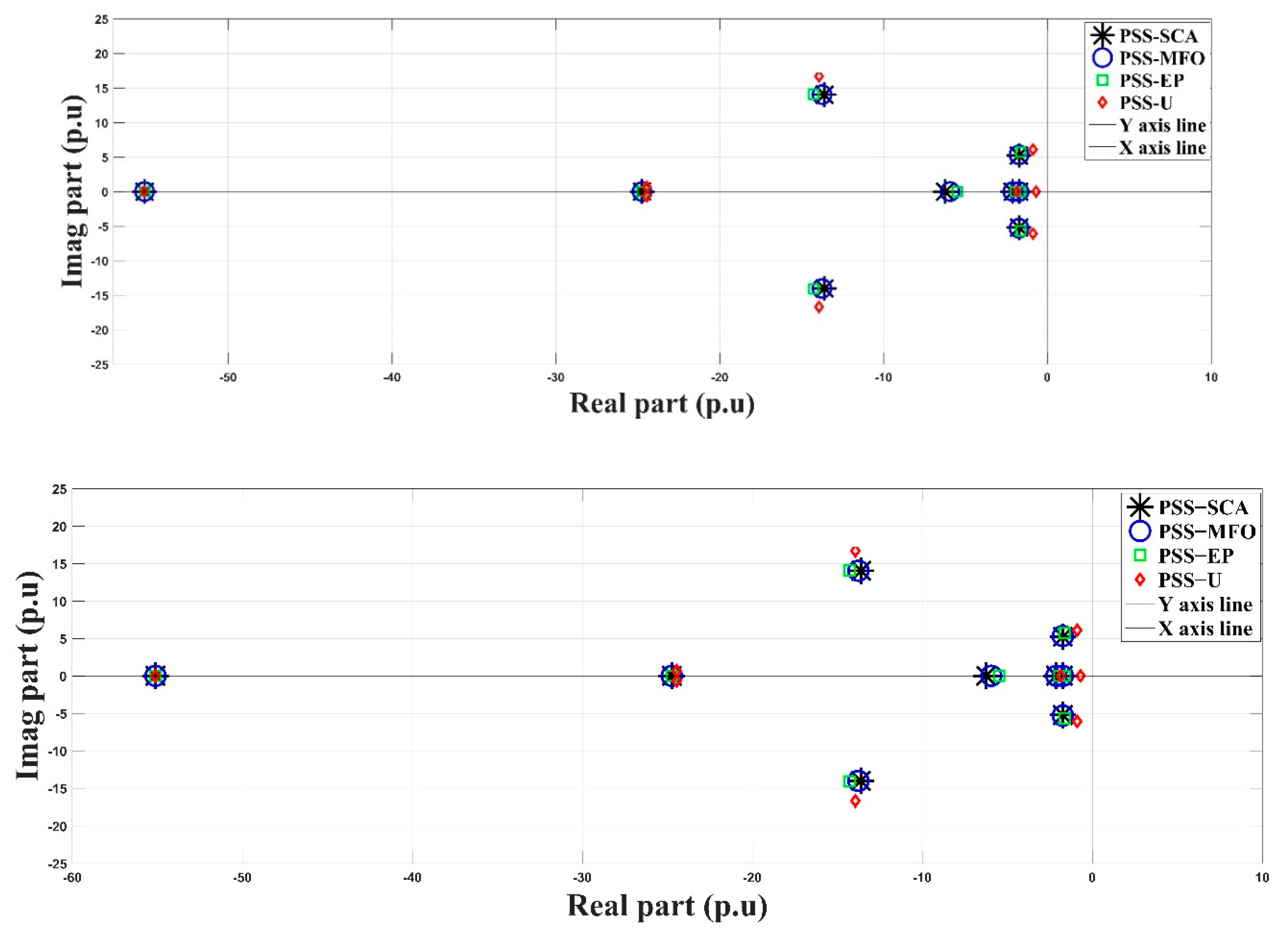

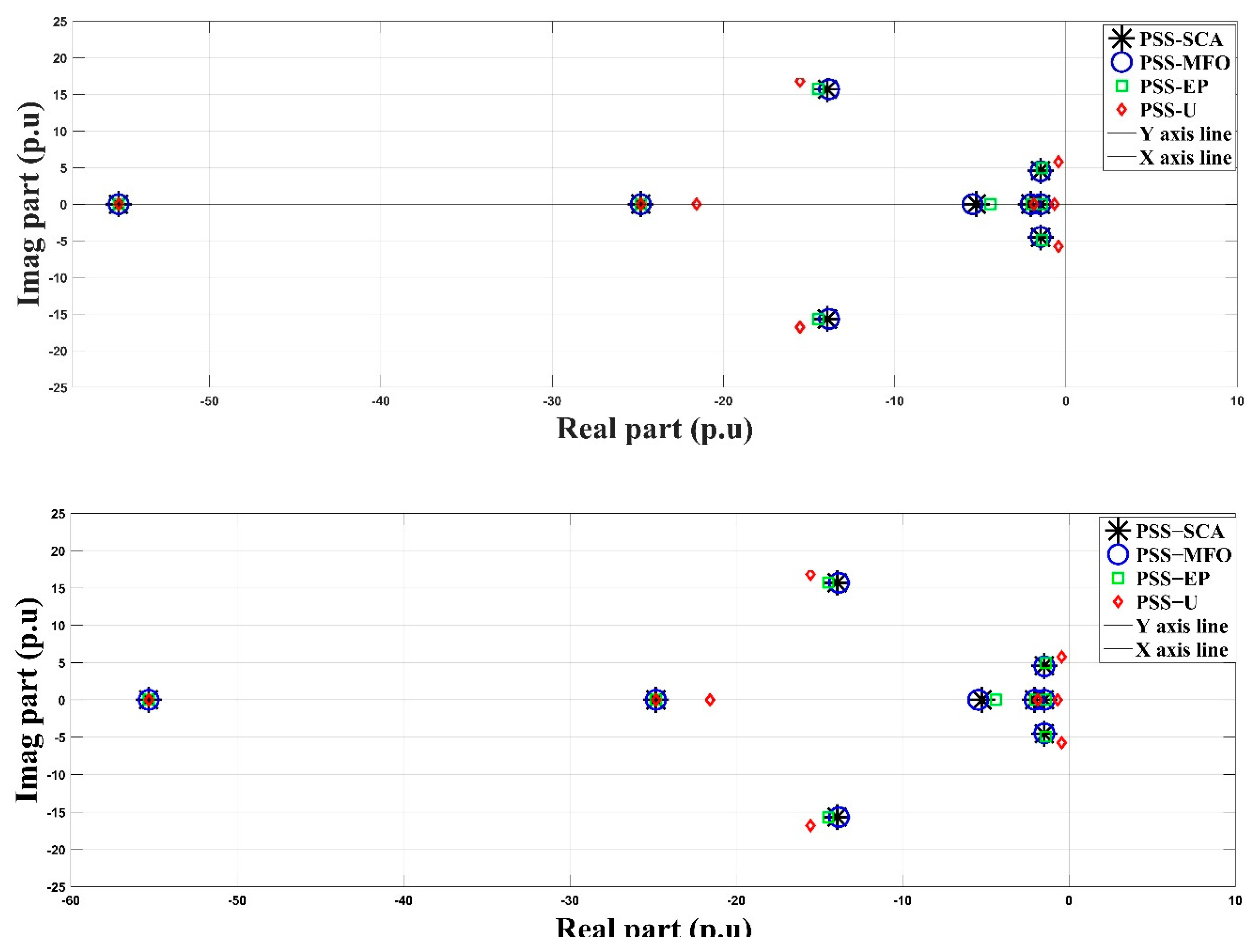
| Cases | Loading Condition (P, Q) | |
|---|---|---|
| Active Load, P (p. u) | Reactive Load, Q (p. u) | |
| case 1 | P = 0.9 | Q = 0.3 |
| case 2 | P = 0.5 | Q = 0.5 |
| case 3 | P = 0.2 | Q = 0.7 |
| Components | List of Parameters |
|---|---|
| Generator | H = 3.5, , Xd’ = 0.3, Ra = 0.003, Xd = 1.81, Xq = 1.76, Td0’ = 8, Ksd = 0.8491, Ksq = 0.8491. |
| Transmission line | Re = 0, Xe = 0.65, XL = 0.16 |
| Exciter and PSS | KA = 200, TR = 0.02, |
| Type | Objective Function | |||
|---|---|---|---|---|
| PSS-SCA | 0.4884 | 0.4327 | 0.2087 | −2.0298 |
| PSS-MFO | 0.4886 | 0.4330 | 0.2122 | −2.0294 |
| PSS-EP | 0.4886 | 0.4351 | 0.2167 | −2.0292 |
| PSS-U | 1.5 | 0.2 | 0.05 | −0.6881 |
| Type | Objective Function | |||
|---|---|---|---|---|
| PSS-SCA | 0.4324 | 1.1595 | 0.3583 | −1.7267 |
| PSS-MFO | 0.4472 | 1.1022 | 0.3513 | −1.7262 |
| PSS-EP | 0.5868 | 0.7875 | 0.2826 | −1.6269 |
| PSS-U | 1.5 | 0.2 | 0.05 | −0.6812 |
| Type | Objective Function | |||
|---|---|---|---|---|
| PSS-SCA | 0.4858 | 3.8352 | 0.4601 | −1.4738 |
| PSS-MFO | 0.4783 | 3.9594 | 0.4618 | −1.4737 |
| PSS-EP | 0.6201 | 2.6964 | 0.3870 | −1.4012 |
| PSS-U | 1.5 | 0.2 | 0.05 | −0.4298 |
Publisher’s Note: MDPI stays neutral with regard to jurisdictional claims in published maps and institutional affiliations. |
© 2021 by the authors. Licensee MDPI, Basel, Switzerland. This article is an open access article distributed under the terms and conditions of the Creative Commons Attribution (CC BY) license (https://creativecommons.org/licenses/by/4.0/).
Share and Cite
Khawaja, A.W.; Kamari, N.A.M.; Zainuri, M.A.A.M. Design of a Damping Controller Using the SCA Optimization Technique for the Improvement of Small Signal Stability of a Single Machine Connected to an Infinite Bus System. Energies 2021, 14, 2996. https://doi.org/10.3390/en14112996
Khawaja AW, Kamari NAM, Zainuri MAAM. Design of a Damping Controller Using the SCA Optimization Technique for the Improvement of Small Signal Stability of a Single Machine Connected to an Infinite Bus System. Energies. 2021; 14(11):2996. https://doi.org/10.3390/en14112996
Chicago/Turabian StyleKhawaja, Abdul Waheed, Nor Azwan Mohamed Kamari, and Muhammad Ammirrul Atiqi Mohd Zainuri. 2021. "Design of a Damping Controller Using the SCA Optimization Technique for the Improvement of Small Signal Stability of a Single Machine Connected to an Infinite Bus System" Energies 14, no. 11: 2996. https://doi.org/10.3390/en14112996
APA StyleKhawaja, A. W., Kamari, N. A. M., & Zainuri, M. A. A. M. (2021). Design of a Damping Controller Using the SCA Optimization Technique for the Improvement of Small Signal Stability of a Single Machine Connected to an Infinite Bus System. Energies, 14(11), 2996. https://doi.org/10.3390/en14112996







